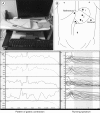Clinical application of electrogastrography in patients with stomach cancer who undergo distal gastrectomy
- PMID: 24765537
- PMCID: PMC3996249
- DOI: 10.5230/jgc.2014.14.1.47
Clinical application of electrogastrography in patients with stomach cancer who undergo distal gastrectomy
Abstract
Purpose: Electrogastrography is a method of measuring action potentials of the stomach. The purpose of this study was to investigate early postoperative changes in the electrogastrography and determine the correlation between electrogastrography and quality of life of patients with stomach cancer who underwent distal gastrectomy.
Materials and methods: This study analyzed 20 patients with stomach cancer who underwent electrogastrography and quality of life was measured 1, 12, and 24 weeks after the operation. Quality of life-C30 version 3.0 and quality of life-STO22, were used.
Results: Fasting and postprandial mean dominant frequency at 1 week after the operation was 2.7 and 2.7 cycles per minute, and 2.8 and 2.7 cycles per minute at 12 weeks, 2.6 and 2.8 cycles per minute at 24 weeks. Fasting and postprandial mean dominant power at 1 week was 36.5 and 36.4 dB, 36.3 and 40.1 dB at 12 weeks and 40.9 and 42.3 dB at 24 weeks. The percentage of tachygastria was increased whereas the percentage of bradygradia was decreased during the postoperative periods (P<0.05). Global health, physical, emotional and social functioning scales were improved, but role and cognitive functioning were not changed. Pain, insomnia, diarrhea and financial difficulties were significantly improved according to the postoperative periods (P<0.05). The correlation between the STO22 and electrogastrography parameters was not significant (P>0.05).
Conclusions: These may suggest that electrogastrography is a simple and noninvasive method and may be applicated for evaluating motility and autonomic functions of the remnant stomach.
Keywords: Distal gastrectomy; Electrogastrography; Stomach neoplasms.
Figures
Similar articles
-
Pre- and postoperative electrogastrography in patients with gastric cancer.Hepatogastroenterology. 2005 Mar-Apr;52(62):639-44. Hepatogastroenterology. 2005. PMID: 15816495
-
Transcutaneous electrogastrography: a non-invasive method to evaluate post-operative gastric disorders?Hepatogastroenterology. 1999 Mar-Apr;46(26):1244-8. Hepatogastroenterology. 1999. PMID: 10370700
-
Electrogastrography in children with cystic fibrosis.Dig Dis Sci. 2002 Apr;47(4):699-703. doi: 10.1023/a:1014711226820. Dig Dis Sci. 2002. PMID: 11991595
-
Electrogastrography: basic knowledge, recording, processing and its clinical applications.J Gastroenterol Hepatol. 2005 Apr;20(4):502-16. doi: 10.1111/j.1440-1746.2004.03751.x. J Gastroenterol Hepatol. 2005. PMID: 15836697 Review.
-
Electrogastrography measurement systems and analysis methods used in clinical practice and research: comprehensive review.Front Med (Lausanne). 2024 Jul 1;11:1369753. doi: 10.3389/fmed.2024.1369753. eCollection 2024. Front Med (Lausanne). 2024. PMID: 39011457 Free PMC article.
Cited by
-
Electrogastrography in Patients with Functional Dyspepsia, Joint Hypermobility, and Diabetic Gastroparesis.Turk J Gastroenterol. 2022 Mar;33(3):182-189. doi: 10.5152/tjg.2021.20853. Turk J Gastroenterol. 2022. PMID: 35115288 Free PMC article.
-
Gastric Myoelectric Activity and Body Composition Changes during Weight Loss via Sleeve Gastrectomy and Lifestyle Modification: Prospective Cohort Study.Healthcare (Basel). 2023 Apr 12;11(8):1105. doi: 10.3390/healthcare11081105. Healthcare (Basel). 2023. PMID: 37107939 Free PMC article.
References
-
- Quigley EMM. Gastric motor and sensory function and motor disorders of the stomach. In: Feldman M, Friedman LS, Brandt LJ, editors. Sleisenger & Fordtran's Gastrointestinal and Liver Disease Pathophysiology/Diagnosis/Management. 8th ed. Philadelphia: WB Saunders/Elsevier; 2006. pp. 999–1028.
-
- Parkman HP, Hasler WL, Barnett JL, Eaker EY American Motility Society Clinical GI Motility Testing Task Force. Electrogastrography: a document prepared by the gastric section of the American Motility Society Clinical GI Motility Testing Task Force. Neurogastroenterol Motil. 2003;15:89–102. - PubMed
-
- Alvarez WC. The electrogastrogram and what it shows. JAMA. 1922;78:1116–1119.
-
- Smout AJPM, Jebbink HJA, Samson JM. Acquisition and analysis of electrogastrographic data, the Dutch experience. In: Chen JZ, McCallum RW, editors. Electrogastrography, Principles and Applications. New York: Raven Press; 1994. pp. 3–30.
LinkOut - more resources
Full Text Sources
Other Literature Sources
Miscellaneous



